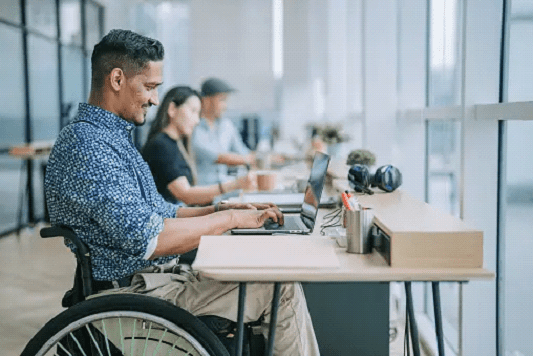adrianse* Global announces a strategic partnership with Loop Interiors
This partnership will extend both company's reach to offer clients a truly global service across Europe and APAC region.

In today's fast-paced work environment, it's crucial to make office spaces more mobile and accessible for everyone. Focus on mobility and accessibility is key to fostering inclusivity and a positive work culture. Creating an environment that allows for seamless movement not only improves productivity, but also enhances employee satisfaction and well-being. In this article, we will explore the essential elements for promoting mobility and accessibility in any office space. Let's dive in!
Ergonomic Workstations
To enhance mobility and accessibility, it all begins with the foundation: the workstation. Ergonomic furniture, such as adjustable desks and chairs, allows employees to personalize their workstations to suit their individual needs. The ability to change positions, alternate between sitting and standing, and adjust monitor heights promotes comfort and makes it easy for the employees to adapt to their work environment faster.
Beyond the benefits of comfort and physical health, ergonomic workstations play a crucial role in accommodating employees with disabilities. Whether it's adjusting the desk height to accommodate a wheelchair or customizing the chair to provide optimal support, ergonomic workstations ensure that employees with disabilities can work comfortably and efficiently.
Clear Signage and Wayfinding
Implementing clear signage and wayfinding systems is essential for guiding employees and visitors through the office space. Well-designed signage should include room names, directions to important areas, and accessible routes. This way, we can ensure that everyone can easily navigate the office without confusion and time wastage.
In order to promote inclusivity, it's essential to consider the needs of individuals with visual impairments. Incorporating braille in signage is a powerful step toward creating an accessible workplace. By including braille alongside visual text, we ensure that individuals with visual impairments can independently navigate the office environment.
When designing signage, using high-contrast colors, large fonts, and clear pictograms enhances visibility for everyone, including those with visual impairments. These design elements make it easier for individuals to read and comprehend the information provided, facilitating smooth navigation.
Thoughtful Layout and Pathways
A well-designed office layout plays a significant role in ensuring smooth movement flow. When planning your office space, consider creating wider doorways and hallways that allow space for the employees to walk around freely and facilitate easy passage of wheelchairs and other mobility aids without feeling cramped or obstructed. Remove unnecessary barriers and clutter, and strategically position furniture, equipment, and communal areas to facilitate seamless navigation. By establishing clear pathways, you create an environment that is conducive to collaboration and minimizes unnecessary disruptions.
Accessible Facilities and Amenities
An organization should be inclusive not just in their work culture, but also in their office space design too. Workspaces should prioritize accessibility for all employees, including those with disabilities. Install ramps, elevators, and handrails to ensure easy access to all areas of the office, including common areas, meeting rooms, and restrooms. It is also crucial to incorporate the guidelines outlined in the Rights of Persons with Disabilities (RPWD) Act.
The RPWD Act provides valuable insights and recommendations for creating accessible environments. Designate parking spaces for people with disabilities, and provide doorways and corridors that are wide enough to accommodate wheelchair users. This way, we can ensure a positive work environment where everyone feels included.
When an office space is thoughtfully designed to prioritize mobility and accessibility, it sends a clear message of commitment to promoting equal access and inclusivity. Such a design fosters a professional environment that values its workforce's diverse abilities and needs.
Ultimately, a well-designed office space that emphasizes mobility and accessibility cultivates a positive work culture and promotes employee satisfaction and well-being. It signifies an organization's dedication to providing equal opportunities for all employees, regardless of their abilities. By embracing these principles, we can create an environment where success can truly blossom.
